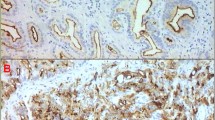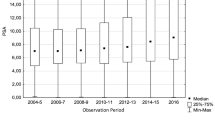Abstract
Clinical management of incidental prostate cancer (IPC) remains challenging since its clinical course cannot be predicted by conventional histopathology. Aiming to define predictive factors in IPC, we correlated the immunohistochemically detected expression of prostate-specific antigen (PSA), prostatic acid phosphatase (PSAP), alpha-methylacyl-CoA racemase (AMACR, p504s), and androgen receptor in transurethral resection specimens with Gleason scores and histologic staging on the corresponding radicals in a cohort of 54 patients (mean age, 65.9 years; range, 49–80 years). PSAP expression showed a significant correlation with tumor staging (ρ = −0.37; p = 0.02) but not with Gleason scores (ρ = −0.06; p = 0.69). K-statistics revealed a highly significant moderate interobserver agreement concerning the evaluation of PSAP staining (K = 0.47; p < 0.001). In contrast, the other markers assessed failed to correlate with conventional histopathology. Therefore, PSAP might be predictive of tumor stage in IPC and represent a valuable adjunct for clinical decisions in terms of individual therapeutic management.




Similar content being viewed by others
References
Van Andel G, Vleeming R, Kurth KH et al (1995) Incidental carcinoma of the prostate. Semin Surg Oncol 11:36–45
Sheldon CA, Williams RD, Fraley EE (1980) Incidental carcinoma of the prostate: a review of the literatur and critical reappraisal of classification. J Urol 124:626–631
Jewett HJ (1975) The present status of radical prostatectom for stages A and B prostatic cancer. Urol Clin North Am 2:105–124
Sobin LH, Wittekind CH (2002) TNM classification of malignant tumors, 6th edn. Wiley-Liss, New York, pp 172–175
Kononen J, Bubendorf L, Kallioniemi A et al (1998) Tissue microarrays for high-throughput molecular profiling of tumor specimens. Nat Med 4:844–847
Mazzuchelli R, Barbisan F, Scarpelli M et al (2009) Is incidentally detected prostate cancer in patients undergoing radical cystoprostatectomy clinically significant? Am J Clin Pathol 131:279–283
Paul R, Knebel C, van Radenborgh H et al (2005) [Incidental carcinoma of the prostate: can we and should we recommend radical prostatectomy?]. Urologe A 44:1054–1058
Reich O, Gratzke C, Bachmann A et al (2008) Morbidity, mortality and early outcome of transurethral resection of the prostate: a prospective multicenter evaluation of 10, 654 patients. J Urol 180:246–249
Martino P, Palazzo S, Battaglia M et al (2004) Incidental prostatic cancer: repeat TURP or biopsy? Urol Int 73:193–197
Miller JS, Donovan JF Jr, Williams RD et al (1990) Evaluation and treatment of stage A prostate cancer. In: Williams RD, Carroll PR (eds) Treatment perspectives in urologic oncology. Pergamon, Elmsford, pp 113–134
Greene DR, Egawa S, Neerhut G et al (1991) The distribution of residual cancer in radical prostatectomy specimens in stage A prostate cancer. J Urol 145:324–328
Zhang G, Wassermann NF, Kapoor DA et al (1992) Early detection of local progressive disease from stage A1 prostate carcinoma by transrectal ultrasonography. Cancer 69:2300–2305
Barnes R, Hirst A, Rosenquist R (1976) Early carcinoma of the prostate: comparison of stages A and B. J Urol 115:404–405
Bostwick DG (1995) The pathology of incidental carcinoma. Cancer Surv 23:7–18
Friedman GD, Hiatt RA, Quesenberry CP Jr et al (1991) Case-control study of screening for prostate cancer by digital rectal examination. Lancet 337:1526–1530
Varma M, Berney DM, Jasani B et al (2004) Technical variations in prostatic immunohistochemistry: need for standardisation and stringent quality assurance in PSA and PSAP immunostaining. J Clin Pathol 57:687–690
Ablin RJ (1997) A retrospective and prospective overview of prostate-specific antigen. J Cancer Res Clin Oncol 123:583–594
Kim J, Coetzee GA (2004) Prostate specific gene regulation by androgen receptor. J Cell Biochem 93:233–241
Gunia S, May M, Scholman K et al (2008) Expression of alpha-methylacyl-CoA racemase correlates with histopathologic grading in noninvasive bladder cancer. Virchows Arch 453:165–170
Zha S, Ferdinadusse S, Hicks JL et al (2005) Peroxisomal branched chain fatty acid beta-oxidation pathway is upregulated in prostate cancer. Prostate 63:316–323
Hameed O, Humphrey PA (2005) Immunohistochemistry in diagnostic surgical pathology of the prostate. Semin Diagn Pathol 22:88–104
Acknowledgements
The authors gratefully thank Frank Dietrich, MD, Conrad Flössel, MD, Jan Jander, MD, Helmut Knispel, MD, Hartmut Lobeck, MD, Volker Loy, MD, Roland Pauli, MD, Volkmar Rosenthal, MD, and Wilko Weichert, MD, for their contribution to this work.
Conflict of interest statement
All authors and participants involved in this study have no conflict of interest.
Author information
Authors and Affiliations
Corresponding author
Rights and permissions
About this article
Cite this article
Gunia, S., Koch, S., May, M. et al. Expression of prostatic acid phosphatase (PSAP) in transurethral resection specimens of the prostate is predictive of histopathologic tumor stage in subsequent radical prostatectomies. Virchows Arch 454, 573–579 (2009). https://doi.org/10.1007/s00428-009-0759-1
Received:
Revised:
Accepted:
Published:
Issue Date:
DOI: https://doi.org/10.1007/s00428-009-0759-1




